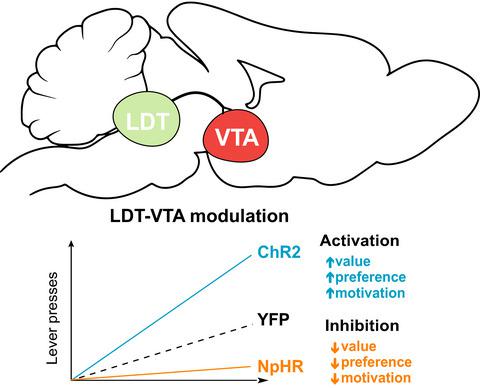当前位置:
X-MOL 学术
›
J. Neurosci. Res.
›
论文详情
Our official English website, www.x-mol.net, welcomes your feedback! (Note: you will need to create a separate account there.)
Laterodorsal tegmentum–ventral tegmental area projections encode positive reinforcement signals
Journal of Neuroscience Research ( IF 4.2 ) Pub Date : 2021-08-10 , DOI: 10.1002/jnr.24931 Bárbara Coimbra 1, 2 , Ana Verónica Domingues 1, 2 , Carina Soares-Cunha 1, 2 , Raquel Correia 1, 2 , Luísa Pinto 1, 2 , Nuno Sousa 1, 2 , Ana João Rodrigues 1, 2
Journal of Neuroscience Research ( IF 4.2 ) Pub Date : 2021-08-10 , DOI: 10.1002/jnr.24931 Bárbara Coimbra 1, 2 , Ana Verónica Domingues 1, 2 , Carina Soares-Cunha 1, 2 , Raquel Correia 1, 2 , Luísa Pinto 1, 2 , Nuno Sousa 1, 2 , Ana João Rodrigues 1, 2
Affiliation

|
The laterodorsal tegmentum (LDT) is a brainstem nucleus classically involved in REM sleep and attention, and that has recently been associated with reward-related behaviors, as it controls the activity of ventral tegmental area (VTA) dopaminergic neurons, modulating dopamine release in the nucleus accumbens. To further understand the role of LDT–VTA inputs in reinforcement, we optogenetically manipulated these inputs during different behavioral paradigms in male rats. We found that in a two-choice instrumental task, optical activation of LDT–VTA projections shifts and amplifies preference to the laser-paired reward in comparison to an otherwise equal reward; the opposite was observed with inhibition experiments. In a progressive ratio task, LDT–VTA activation boosts motivation, that is, enhances the willingness to work to get the reward associated with LDT–VTA stimulation; and the reverse occurs when inhibiting these inputs. Animals abolished preference if the reward was omitted, suggesting that LDT–VTA stimulation adds/decreases value to the stimulation-paired reward. In addition, we show that LDT–VTA optical activation induces robust preference in the conditioned and real-time place preference tests, while optical inhibition induces aversion. The behavioral findings are supported by electrophysiological recordings and c-fos immunofluorescence correlates in downstream target regions. In LDT–VTA ChR2 animals, we observed an increase in the recruitment of lateral VTA dopamine neurons and D1 neurons from nucleus accumbens core and shell; whereas in LDT–VTA NpHR animals, D2 neurons appear to be preferentially recruited. Collectively, these data show that the LDT–VTA inputs encode positive reinforcement signals and are important for different dimensions of reward-related behaviors.
中文翻译:

背侧被盖-腹侧被盖区域投影编码正强化信号
背侧被盖 (LDT) 是经典参与 REM 睡眠和注意力的脑干核,最近与奖赏相关行为有关,因为它控制腹侧被盖区 (VTA) 多巴胺能神经元的活动,调节多巴胺释放伏隔核。为了进一步了解 LDT-VTA 输入在强化中的作用,我们在雄性大鼠的不同行为范式中对这些输入进行了光遗传学操作。我们发现,在一项两项选择的仪器任务中,与其他相同的奖励相比,LDT-VTA 投影的光学激活会改变并放大对激光配对奖励的偏好;在抑制实验中观察到相反的情况。在渐进比率任务中,LDT-VTA 激活会提高动机,即 提高工作意愿以获得与 LDT-VTA 刺激相关的奖励;当禁止这些输入时会发生相反的情况。如果省略奖励,动物会取消偏好,这表明 LDT-VTA 刺激会增加/减少刺激配对奖励的价值。此外,我们表明 LDT-VTA 光学激活在条件和实时位置偏好测试中诱导强烈偏好,而光学抑制诱导厌恶。行为发现得到了电生理记录的支持,并且下游目标区域的 c-fos 免疫荧光相关。在 LDT-VTA ChR2 动物中,我们观察到伏隔核核心和外壳的侧向 VTA 多巴胺神经元和 D1 神经元的募集增加。而在 LDT-VTA NpHR 动物中,D2 神经元似乎被优先招募。
更新日期:2021-08-10
中文翻译:

背侧被盖-腹侧被盖区域投影编码正强化信号
背侧被盖 (LDT) 是经典参与 REM 睡眠和注意力的脑干核,最近与奖赏相关行为有关,因为它控制腹侧被盖区 (VTA) 多巴胺能神经元的活动,调节多巴胺释放伏隔核。为了进一步了解 LDT-VTA 输入在强化中的作用,我们在雄性大鼠的不同行为范式中对这些输入进行了光遗传学操作。我们发现,在一项两项选择的仪器任务中,与其他相同的奖励相比,LDT-VTA 投影的光学激活会改变并放大对激光配对奖励的偏好;在抑制实验中观察到相反的情况。在渐进比率任务中,LDT-VTA 激活会提高动机,即 提高工作意愿以获得与 LDT-VTA 刺激相关的奖励;当禁止这些输入时会发生相反的情况。如果省略奖励,动物会取消偏好,这表明 LDT-VTA 刺激会增加/减少刺激配对奖励的价值。此外,我们表明 LDT-VTA 光学激活在条件和实时位置偏好测试中诱导强烈偏好,而光学抑制诱导厌恶。行为发现得到了电生理记录的支持,并且下游目标区域的 c-fos 免疫荧光相关。在 LDT-VTA ChR2 动物中,我们观察到伏隔核核心和外壳的侧向 VTA 多巴胺神经元和 D1 神经元的募集增加。而在 LDT-VTA NpHR 动物中,D2 神经元似乎被优先招募。



























 京公网安备 11010802027423号
京公网安备 11010802027423号